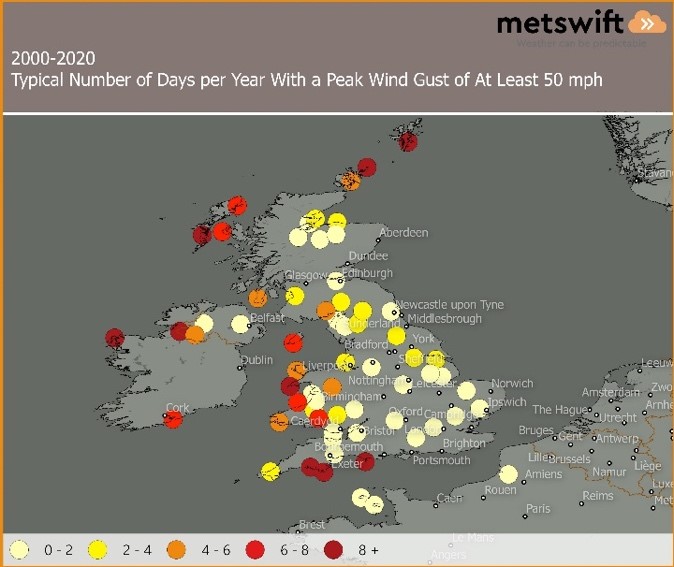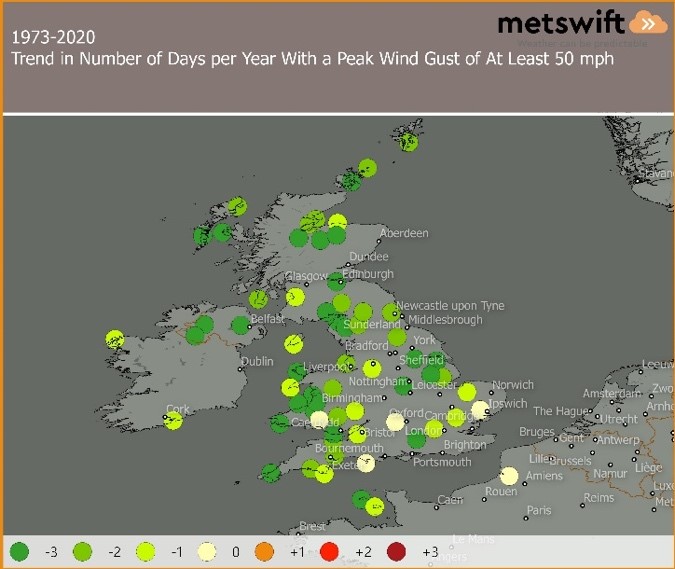UK & Ireland

Climate change is already affecting our daily lives, but its effects upon the weather will become far more marked in the years to come. The most recent reports, such as the highly influential AR6 Climate Change 2021 report from the Intergovernmental Panel on Climate Change (IPCC), indicate that extreme weather events are likely to become much more frequent towards the end of this century.
Closer to home, in Britain and Ireland the effects of climate change will be widespread and varied. Warmer oceans mean increased rainfall. Storms may become stronger but less frequent, summer heatwaves hotter and more common, droughts more prevalent and the winter months significantly wetter. The potential changes present significant financial risks to property, through increased incidences of flooding, subsidence, and storm damage. Location intelligence can help identify, quantify, and reduce that risk, making it useful for decision makers, investors, and regulators.
What We Already Know About Climate Change and Property Risk
Gamma Location Intelligence (Gamma LI) works closely with recognised experts in flooding, subsidence, and parametric weather risk insights to assess the likely effects on property of the changing climate.
As a result of global climate change, Great Britain and Ireland are becoming increasingly affected by flooding. In some scenarios, an additional 1.3 million British properties will be at risk of flooding by 2050, particularly on the south and east coasts. In Ireland, the rise in sea levels and the more frequent and extreme storms will result in as many as 70,000 addresses being exposed to damage from coastal flooding. Although the flood risk has been widely discussed, less attention has been paid to the potential future effects of climate change on ground movement.
Drier and hotter summers are already reducing soil moisture levels, leading to shrinkage, while intense rainfall and wetter winters have caused swelling, particularly in certain types of soil. This shrink–swell process is a leading cause of property damage and subsidence. We are reaching the point where extreme years of subsidence claims, such as 1990/1991, 1997/1998 and 2018, could become the new normal. Therefore, being able to visualise and assess this ever-increasing risk properly will be vital over the years to come. Working with Terrafirma’s high-quality, up-to-date insights on subsidence and other ground risks, Gamma LI has predicted that a total of 10.2 million property addresses in Great Britain will be at elevated risk of subsidence by 2050 due to climate change. The risk of subsidence is expected to increase especially in areas where clay soils are prevalent, such as the North-East and the West Midlands.
Moreover, property insurance premiums are affected by the impact that storms and wind speeds have on buildings and the built environment, which mainly depends on their proximity to trees and river estuaries. However, the windstorm evidence and projections for the impact of climate change are not well developed. The IPCC 2021 report (Section 12.4.5) finds with medium confidence that the frequency and intensity of storms, including strong winds and extra-tropical storms, is likely to increase in northern and central Europe.[1]
Although the prediction of increased frequency is less certain, there is strong evidence for a projected increase in the intensity of windstorm events. Speed is the most destructive element, but the coastal nature of much of the UK also means that the stronger, faster windstorms associated with rises in sea levels can cause catastrophic damage due to sea surges and coastal erosion.
Windstorms Can Wreak Havoc
Windstorms are amongst the most damaging natural hazards. The UK and Ireland are more prone to strong wind events than many other regions. They can hit at any time of year, too. For example, in August 2020 there were damaging summer season events: Storms Ellen and Francis. Both led to power outages, closed the M48 at the Severn Bridge, and caused significant travel disruption. Wind gusts topped 50 mph for many inland areas and reached near 70 mph on some coasts.
In autumn and winter, even more powerful storms are unleashed, including the recent Storm Corrie, which struck northern UK on 30 January 2022. The most extreme historical examples are the Burn’s Day storm of 25 January 1990 and the Great Storm of 15–16 October 1987. Both required large-scale clear-up and repair operations. Gamma LI asked MetSwift, our parametric weather risk data partner, to provide an overview of the UK and Ireland windstorms.
Seasonal Trends Are Down
UK residents will not be surprised to read that autumn and winter tend to have more windstorms than spring and summer (see table below). What may raise eyebrows is how small that difference has become in the most recent decades. Based on data from over 1000 weather stations across the UK, the difference in the average number of windy days in winter compared to spring in the 1970s was 7–8, which fell to 3–4 in the 2010s.
| Typical Number of Days per Year with Wind Gusts of Over 50 mph | |||||
| Months | 1970s | 1980s | 1990s | 2000s | 2010s |
| Dec-Feb | 13.57 | 11.99 | 7.86 | 5.51 | 5.96 |
| Mar-May | 7.96 | 9.96 | 5.45 | 3.25 | 3.07 |
| Jun-Aug | 5.98 | 7.05 | 3.74 | 2.21 | 2.56 |
| Sep-Nov | 12.61 | 11.20 | 5.44 | 4.12 | 3.66 |
Those frequencies also show a decreasing trend in all seasons, especially for March–May and September–November. The other two seasons had a slight uptick in the 2010s compared to the 2000s. The behaviour in the 2020s may indicate whether this is a change in the trend or a fluctuation.
Similar Trends Regardless of Local Climate
The west and north of the UK are more often affected by strong winds, and the south-east least (see below left). Exposed coastal sites in the west and north tend to see at least 8 days per year when wind gusts reach 50 mph. In contrast, much of the south-east usually has less than 2, as highlighted below for selected weather stations.


This pattern is strongly defined by the typical path of Atlantic windstorms (which originate over the Atlantic before moving onshore). Moving east or northeast, they pass near or over northern parts of the UK.
Despite being so pronounced; this pattern has little impact upon the overall trend. From the Isle of Skye to West Sussex, there are places where there are several less windy days per year. In fact, almost every part of the British Isles now enjoys a lower frequency of disruptive wind gusts compared to the 20th century.
The Future: Not Very Wild?
A simple extrapolation forward from this trend would mean that by the 2050s, even western and northern coasts would experience only an average of 3 or 4 strong wind events each year. Further, in the south-east, there would only be 1 or 2 every 3–4 years, and sometimes more than 12 months would go by without one.
However, that’s not to say that they will be less intense when they do occur. In fact, considering the IPCC 2021 report, their intensity may well increase. Not only that, but weather tends to follow cycles rather than linear changes, so it will be more important than ever to stay informed when stormier runs of weather are most likely to occur. Complacency can be very costly.
How plausible is this projection? Well, there is some evidence that climate change is associated with a northward shift in the typical path of North Atlantic windstorms, as the tropical and subtropical climate zones expand further from the equator. Moreover, the accelerated rate of warming in the Arctic compared to adjacent regions could be reducing how often the conditions required for windstorms come together. However, when they do, warmer North Atlantic waters provide additional energy, raising the upper limit for storm intensity.
These changes have a high probability of continuing for many decades, and with time, they may dampen the impact of opposing ‘cool’ stages in ocean cycles, reducing the variability and, perhaps, predictability these once offered.
To provide the best guidance for the months and years ahead, MetSwift’s advanced statistical model analyses both climate trends and shorter-timescale cycles in the atmosphere and oceans. Employing a specific type of this methodology, predictions issued each December from 2010 to 2020 for the number of Atlantic hurricanes expected in the following season proved 26% more accurate than the next-best forecasts issued that month (which were published by Tropical Storm Risk).
Addressing Today for the Unwritten Tomorrow
Measuring the true exposure in property risk is a complicated subject. Adding in the environmental effects of climate change makes it even more complex. Drier summers are causing more subsidence. Flooding will become much more prevalent due to wetter winters, rises in sea levels and more intense storms. These changes will not be evenly distributed, and some areas will become affected by such disruption for the first time.
It is undeniable that high-risk events associated with climate change are increasing in frequency and severity. The insurance market – and asset owners more generally – face a growing need for a much more comprehensive approach to underwriting, pricing, and investment strategies. As we are beginning to see the effects of global warming, Gamma LI can give insurers, MGAs, and lenders the right data at the right time, allowing them to understand what the potential impacts might be and enabling them to make informed decisions quickly.
The MetSwift’s study provides granular detail on the direction the strong wind events may take over the next decade. Notably, it points to a stronger declining trend in the north, where big storms have historically been most common. Models like this can offer an accurate and location-specific risk profile for the upcoming years.
In conclusion, the IPCC report indicates a potential increase in the frequency and intensity of storms across northern Europe by the end of the 21st century. However, this may not be consistent across all countries.
MetSwift’s study of historical data for the UK and Ireland indicates that the number of very windy days seems to be decreasing across all seasons and there is a northward trend in windstorm paths relative to the UK which appears likely to continue in the coming decades.
However, as the MetSwift analysis did not investigate intensity change, when storms do occur their intensity may be similar to or higher than now. Further investigation is required and Gamma LI & MetSwift look forward to continuing our research into climate change trends in the future.
If you want to learn more about our risk assessment solutions, please contact us.
We would be delighted to hear from you.
About Gamma Location Intelligence
Gamma Location Intelligence (Gamma LI) is a cloud hosted solutions provider that integrates software, data, and services to help our clients reduce risk through location intelligence. Established in Dublin, Ireland in 1993, and with offices in Manchester, UK and Bilbao, Spain, the company has expanded to become a global provider of cloud-native location intelligent systems and services. Gamma LI’s Perilfinder™ risk mapping platform provides property underwriters with access to trusted property-level risk data easily, quickly and accurately.
About MetSwift
MetSwift is a UK leading and award-winning* independent global weather provider, privately owned, originally born out of sporting event forecasting for major global events. The company has since diversified into the longer-term aspect of meteorology, delivering real time, accurate and long-range weather data to the world. Having identified a gap in Contingency insurance market in 2016, for weather insights at the fingertips of decision makers, MetSwift have designed an instant, accurate and user-friendly platform, and API’s delivering Weather and NatCat insights to some of the top Lloyds’ insurers, globally.
[1] While IPCC 2021 refers to future projections based on modelled response of weather systems to ‘expected’ long-term climate changes, MetSwift’s study focuses on the observed trend in strong wind events since the 1970s, using a 50 mph wind gust threshold.



